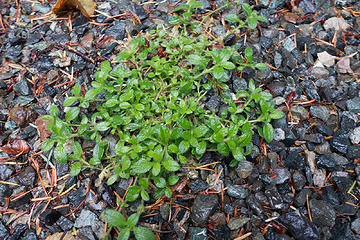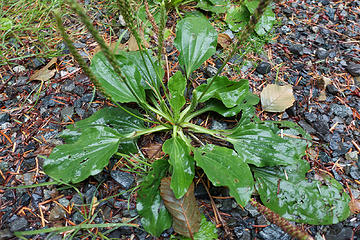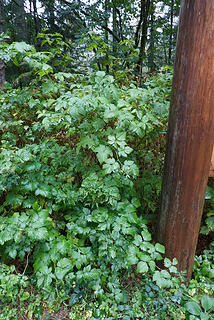| Previous :: Next Topic |
| Author |
Message |
The Angry Hiker
SAR Blacklistee


Joined: 13 Jun 2008
Posts: 2890 | TRs | Pics
Location: Kentwila |
Well, I don't have very many plant allergies, but just being in the vicinity of those things gets my eyes burning. They're blooming like crazy around the Green River right now. Someone went along and uprooted a ton of it and tossed it all on the ground. That seems a little pointless, unless they have a problem with mistaking it for parsnip and eating it.
|
| Back to top |
  
|
 |
Mike Collins
Member


Joined: 18 Dec 2001
Posts: 3096 | TRs | Pics
|
|
| Back to top |
  
|
 |
tigermn
Member


Joined: 10 Jul 2007
Posts: 9242 | TRs | Pics
Location: There... |
 |
tigermn
Member
|
 Mon Jun 04, 2012 12:57 pm |
|
|
Ok that just gives me another reason to remain a carnivore... 
|
| Back to top |
  
|
 |
puzzlr
Mid Fork Rocks


Joined: 13 Feb 2007
Posts: 7220 | TRs | Pics
Location: Stuck in the middle |
 |
puzzlr
Mid Fork Rocks
|
 Sat Sep 26, 2015 1:08 pm |
|
|
I've been doing some invasive weed picking at the Dingford trailhead, mostly for Herb Robert. But I'd like to also learn what native plants like to grow out into the open sunny area there. Here are three of them that I'd like help identifying. It will be easier next spring when they are flowering, but can anyone help now? I'm impatient.
 Dingford trailhead plant  Dingford trailhead plant  Salmonberry at the Dingford trailhead
|
| Back to top |
  
|
 |
Brockton
Member


Joined: 02 Aug 2012
Posts: 266 | TRs | Pics
Location: West Seattle |
 |
Brockton
Member
|
 Sat Sep 26, 2015 1:32 pm |
|
|
I don't know about the first one. Kinnikinnick?
The second one looks like plantain from the look of the leaves and the flower/seed stalk. I believe that's a non-native weed.
The third one is definitely not thimbleberry, which has simple palmate leaves, like a maple leaf. It looks like it could be salmonberry, with the two lower leaflets making the shape of butterfly wings. (That's something I heard about identifying salmonberry.)
|
| Back to top |
  
|
 |
hatchetation
Member


Joined: 11 Jun 2017
Posts: 37 | TRs | Pics
Location: Seattle |
Found these conifer-ish creeping vine things on the trail up to Pratt balcony. There was no woody stem like a young sapling. Just a vine coming out of the ground. Very soft. Weird habit - never seen anything like em.
My best guesses are probably terrible - polytrichum? Cryptomeria japonica?
|
| Back to top |
  
|
 |
Wastral
Member


Joined: 13 Sep 2006
Posts: 199 | TRs | Pics
|
 |
Wastral
Member
|
 Wed Oct 03, 2018 5:02 pm |
|
|
| puzzlr wrote: | I've been doing some invasive weed picking at the Dingford trailhead, mostly for Herb Robert. But I'd like to also learn what native plants like to grow out into the open sunny area there. Here are three of them that I'd like help identifying. It will be easier next spring when they are flowering, but can anyone help now? I'm impatient.
 Dingford trailhead plant  Dingford trailhead plant  Salmonberry at the Dingford trailhead |
1) Creeping Snowberry if fuzzy(can't see well enough), otherwise could be a compact form of Cranberry
2) Common Plantain
3) SalmonBerry
Slap Slap; 10 bugs dead, Blip Blop; Stumble Fall; Curse and Get up and Do it all Over Again; Reaching High For the Sky a Mile High; Topping Out Atop a Peak; Priceless
Slap Slap; 10 bugs dead, Blip Blop; Stumble Fall; Curse and Get up and Do it all Over Again; Reaching High For the Sky a Mile High; Topping Out Atop a Peak; Priceless
|
| Back to top |
  
|
 |
Wastral
Member


Joined: 13 Sep 2006
Posts: 199 | TRs | Pics
|
 |
Wastral
Member
|
 Wed Oct 03, 2018 5:04 pm |
|
|
| hatchetation wrote: | | Found these conifer-ish creeping vine things on the trail up to Pratt balcony. There was no woody stem like a young sapling. Just a vine coming out of the ground. Very soft. Weird habit - never seen anything like em.
My best guesses are probably terrible - polytrichum? Cryptomeria japonica?
|
Pacific Yew is my bet where it has more sunlight than normal. Can look different depending on how much light it gets. If in VERY deep shade it will be VERY dark green leaved and very sprawling, open form. If in more light, the new growth, then a much brighter green and compact form.
Slap Slap; 10 bugs dead, Blip Blop; Stumble Fall; Curse and Get up and Do it all Over Again; Reaching High For the Sky a Mile High; Topping Out Atop a Peak; Priceless
Slap Slap; 10 bugs dead, Blip Blop; Stumble Fall; Curse and Get up and Do it all Over Again; Reaching High For the Sky a Mile High; Topping Out Atop a Peak; Priceless
|
| Back to top |
  
|
 |
gb
Member


Joined: 01 Jul 2010
Posts: 6309 | TRs | Pics
|
 |
gb
Member
|
 Thu Oct 04, 2018 7:48 am |
|
|
|
| Back to top |
  
|
 |
brewermd
Member


Joined: 02 Jun 2008
Posts: 159 | TRs | Pics
|
 |
brewermd
Member
|
 Thu Oct 04, 2018 9:15 am |
|
|
There is an app called inaturalist that would help with these ids. The way it works is that you take a picture and upload into inaturalist and it ids it from a large data bank of pictures that has been accumulating over several years. Works quite with plants and insects but lacks a little in mushrooms. The North Cascades Park people promote the app during their bioblitz activities.
|
| Back to top |
  
|
 |
robertjoy
Member


Joined: 25 Sep 2011
Posts: 107 | TRs | Pics
|
from your link: conium maculatum. google search shows foliage as VERY different from the leaf pattern in question. commons.wikimedia.org/wiki/File:Conium_maculatum_2.jpg
Mosquitoes refuse to bite me,
purely out of respect.
Mosquitoes refuse to bite me,
purely out of respect.
|
| Back to top |
  
|
 |
hatchetation
Member


Joined: 11 Jun 2017
Posts: 37 | TRs | Pics
Location: Seattle |
| gb wrote: | |
Lycopodium. A type of club moss. Match the species at the Burke WTU image collection. |
Ahhh! I think that's it. Lycopodium annotinum perhaps. Thanks! That Burke site is awesome, haven't seen it before. Lead to the pnwherbaria.org entry, with this specimen image.
|
| Back to top |
  
|
 |
gb
Member


Joined: 01 Jul 2010
Posts: 6309 | TRs | Pics
|
 |
gb
Member
|
 Thu Oct 04, 2018 2:56 pm |
|
|
| hatchetation wrote: | | gb wrote: | |
Lycopodium. A type of club moss. Match the species at the Burke WTU image collection. |
Ahhh! I think that's it. Lycopodium annotinum perhaps. Thanks! That Burke site is awesome, haven't seen it before. Lead to the pnwherbaria.org entry, with this specimen image.
|
That is it. I thought you might be better served by doing a bit of investigating on your own. Although most of the images show the club moss to be upright, I've mostly seen it prostrate.
|
| Back to top |
  
|
 |
Sculpin
Member


Joined: 23 Apr 2015
Posts: 1384 | TRs | Pics
|
 |
Sculpin
Member
|
 Fri Oct 05, 2018 7:56 am |
|
|
| gb wrote: | | Lycopodium. A type of club moss. |
A very humble group of plants these days, it was not always so. Wikipedia says:
"During the Carboniferous Period, tree-like Lycopodiophyta (such as Lepidodendron) formed huge forests that dominated the landscape."
They are among the most primitive of vascular plants and have continuously occupied the earth since the Silurian. In my experience they are rather uncommon around here.
The Smithsonian has some very impressive Lycopod fossil tree trunks.
Between every two pines is a doorway to the new world. - John Muir
Between every two pines is a doorway to the new world. - John Muir
|
| Back to top |
  
|
 |
nordique
Member


Joined: 04 May 2008
Posts: 1086 | TRs | Pics
|
 |
nordique
Member
|
 Mon Oct 08, 2018 6:51 pm |
|
|
Thank you, Sculpin!
MANY decades ago, my high school football team was named the Sculpins. And 'Myoxocephalus octodecemspinosus' won me several college biology fieldtrip quizzes!
|
| Back to top |
  
|
 |
|
|